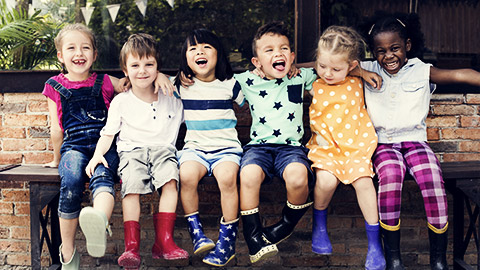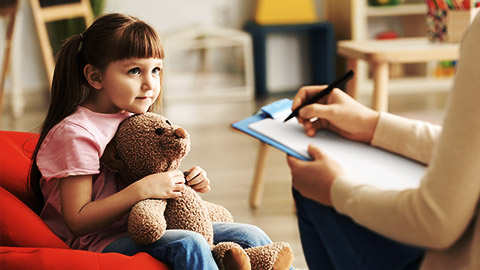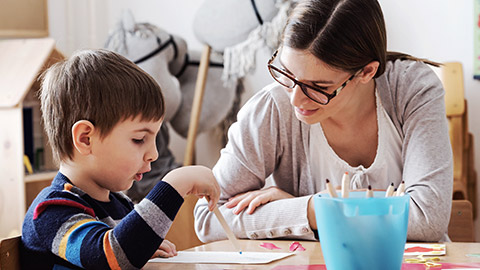In this chapter, we will outline and discuss child-focused work practices in relation to children and young people at risk. We will also identify and discuss communication, observation and other skills for child protection work as well as the responsibility and boundaries in child protection work.
By the end of this chapter, you will understand:
- What is meant by ‘child-focused practice’
- Where to locate information about child-focused practices and approaches
- The key principles for child-focused practice
- ey communication skills for child-focused practice
Child-centred approaches also recognise the child’s unique perspective and experience..

A child-centred or child-focused approach involves keeping the child at the heart of making decisions about their lives and working in partnership with them and their families. The needs of the child are always the primary consideration.
According to the Australian Institute of Family Studies (AIFS), the terms ‘child-focused’ and ‘child-centred’ are often used interchangeably to mean focusing on ‘protecting and promoting children’s safety and wellbeing and ensuring that they are heard in situations that directly affect them’
The AIFS has identified four principles that characterise child-centred approaches:
- Recognising critical times and intervening as early as possible in the life of the child and their problem
- Taking the developmental needs of the child into account
- Providing children and young people with opportunities to participate in decisions that affect them
- Taking a collaborative approach and working with the child’s family, school, community and society/culture
Child-centred approaches also recognise the child’s unique perspective and experience.
Child-Focused Practices

Using child-focused practices means working in ways that are ‘child-friendly’, keep the child safe and keep the child as the focus of the work. The aim is to uphold children’s rights and ensure that children are safe and can reach their full potential.
Child-focused and child-centred approaches are based on a belief that children have the right to grow and develop free from harm and that the best interests of the child should be the primary focus of practice. Child focus practices encompass:
- The learning or care environment
- The organisation’s policies and procedures
- The worker’s knowledge and skills
Other Aspects of Child-Focused Approaches
Child-focused approaches and practices are holistic. This means that the child is seen in context as part of a family, community, social network and culture. Child-focused practices take these considerations into account and work to collaborate with the child’s family and social networks (e.g. school, sporting teams and other social and community contacts and agencies) and acknowledge and respect cultural factors and requirements.
Early Years Learning Framework- EYLF
The Framework draws on conclusive international evidence that early childhood is a vital period in children’s learning and development. It has been developed with considerable input from the early childhood sector, early childhood academics and the Australian and State and Territory Governments.
The Framework forms the foundation for ensuring that children in all early childhood education and care settings experience quality teaching and learning. It has a specific emphasis on play-based learning and recognises the importance of communication and language (including early literacy and numeracy) and social and emotional development. The Framework has been designed for use by early childhood educators working in partnership with families, children’s first and most influential educators
Strength-based approaches are also used in working with children to focus on the child’s social network supports and build the child’s capacity, skills and resilience in line with the principles of strength-based approaches.
Explore these sources for more information about child-focused practices:
- The Good Practice Guide to Child Aware Approaches: Keeping Children Safe and Well by the AIFS
- ‘Services that keep children safe’ from the New South Wales Government Department of Communities and Justice
- Being Becoming & Belonging The Early Years Learning Framework
Connecting to the Guide of the NQF
For more information on how Educational Program and Practice is shaped by children's focus check out the Guide to the NQF and look at Quality Area 1- Educational Program and Practice. There is information relating to the way that educators encompass child focused work practices through the National Quality Framework.
| Quality Area 1 | Educational program and practice | |
|---|---|---|
| Standard 1.1 | Program | The educational program enhances each child’s learning and development. |
| Element 1.1.1 | Approved learning framework | Curriculum decision-making contributes to each child’s learning and development outcomes in relation to their identity, connection with community, wellbeing, confidence as learners and effectiveness as communicators. |
| Element 1.1.2 | Child-centred | Each child’s current knowledge, strengths, ideas, culture, abilities and interests are the foundation of the program. |
| Element 1.1.3 | Program learning opportunities | All aspects of the program, including routines, are organised in ways that maximise opportunities for each child’s learning. |
| Standard 1.2 | Practice | Educators facilitate and extend each child’s learning and development. |
| Element 1.2.1 | Intentional teaching | Educators are deliberate, purposeful, and thoughtful in their decisions and actions. |
| Element 1.2.2 | Responsive teaching and scaffolding | Educators respond to children’s ideas and play and extend children’s learning through open-ended questions, interactions and feedback. |
| Element 1.2.3 | Child directed learning | Each child's agency is promoted, enabling them to make choices and decisions that influence events and their world. |
| Standard 1.3 | Assessment and planning | Educators and co-ordinators take a planned and reflective approach to implementing the program for each child. |
| Element 1.3.1 | Assessment and planning cycle | Each child’s learning and development is assessed or evaluated as part of an ongoing cycle of observation, analysing learning, documentation, planning, implementation and reflection. |
| Element 1.3.2 | Critical reflection | Critical reflection on children’s learning and development, both as individuals and in groups, drives program planning and implementation. |
| Element 1.3.3 | Information for families | Families are informed about the program and their child's progress. |

Communication
Communication is the foundation of child-focused practices. Effective communication, especially active listening skills, is the basis for establishing respectful, trusting relationships with children and young people at risk. Effective communication requires:
- Developing skills in listening, questioning, clarifying and responding to what is being communicated
- Being aware of our body language, facial expressions and tone of voice
- Demonstrating understanding, respect and honesty in all our interactions
- Using age-appropriate communication styles and strategies
The next video is a small explanation of how to communicate effectively.
Effective communication with children and young people includes:
- Listening to the child with the intention to hear and support the child
- Encouraging the child to express themselves and providing praise and encouragement when they do
- Using body language that shows you are interested and care: getting down to the child’s level, making eye contact and using an appropriate tone of voice
- Making sure your interactions are appropriate for the child’s age, including considering how long you engage for and the way you express yourself
The next video is a 2-minute video explaining children's communication skills.
Active Listening
Active listening involves giving the speaker your full attention and actively engaging in the conversation. Here are a few tips to develop the practice of active listening:
- Build on what the child is telling you and show your interest by saying things such as ‘Tell me more about...’, ‘Really!’ and ‘Go on’.
- Observe the child’s facial expressions and body language. Listening is not just about hearing words – it is also about trying to understand what is behind those words.
- Let the child know that you are listening and ensure that you have really understood the important messages that they are telling you. Repeat what the child has said back to them and make lots of eye contact.
- Allow the child time to find the words they want to say – do not interrupt or hurry them.
- Prompt the child only if necessary. This could include sounding out a word they are struggling with or posing a question.
Observation Skills
Good observation skills are essential. Changes in posture, facial expression, gestures, tone of voice and movements can tell us as much as or more than words do.
Observe the child or young person carefully when you are listening to them. Watch for reactions to particular topics or words. For example, if a child flinches away from a particular person, that might indicate fear; if a child looks away or looks down when a topic is introduced, that might indicate they find the topic painful. A change in tone of voice (becoming softer, lounder, more hesitant) often indicates an emotion. Protective or self-soothing gestures and postures, such as hugging oneself, rocking, thumb sucking, can also indicate strong negative emotions.

Asking Questions
There are three kinds of question that you can ask:
Closed questions
They work to close the conversation down by limiting the number of possible responses, which are typically just ‘Yes’, ‘No’ or ‘Maybe’.
Example - Closed questions:
- Did you go to the football on Saturday?
- Did you enjoy the football match?
- When did you go to the football?
Open questions
They work to open the conversation up and usually begin with words such as how, when, what, where, who and why. Open questions elicit details, descriptions and stories. Closed questions check or confirm information.
Example - Open questions:
- How did you feel about your team losing the game on Saturday?
- What did you do on Saturday?
- Why did you miss the match on Saturday?

Probing questions
They seek to gain more information from the person.
Example - Probing questions:
- And then what happened?
- How did you feel about that?
Both closed and open questions are useful, but when communicating with children and young people at risk, you will most likely need to ask a lot of open questions.
Include questions that focus on the specifics of what the child is telling you to elicit more detail and more information about what happened and how the child was affected.
Example - If a child is telling you that they were harmed by a family member, you could ask questions such as:
- So how did this affect your relationship with Uncle Sam?
- Do you think that Uncle Sam was wrong to do that?
- How do you think a good uncle is supposed to behave towards you?
- Did this make it hard for you, given that Uncle Sam was still living in your home? How did you feel about that?
Watch this next video explaining the power of effective questioning and how it can help you in the art of conversation.
Alternative Communication Strategies
Many children and young people find it hard to put certain things into words, so providing alternative ways of communicating may be helpful.
With very young children, it may be more productive to use techniques such as drawing or playing with toys to elicit their story or talk about sensitive subjects.
There are specialised toys, such as anatomically correct dolls, that can be used to gather information in cases of sexual abuse. A word of caution, though: To use these dolls, you need specialised training, and there is debate on their value and concerns about whether they may be suggestive to children.
Enjoy this short video demonstrating non verbal communication.
To find out more about therapeutic dolls, visit the following links:
'Therapeutic Dolls More Than Child’s Play’ from Centacare
'Anatomical Dolls: Their Use in Assessment of Children Who May Have Been Sexually Abused’ from the Journal of Child Sexual Abuse
Judge a man by his questions not his answersVoltaire

Q1: What are some principles that characterise child-centred approaches?
A child-centred or child-focused approach involves keeping the child at the heart of making decisions about their lives and working in partnership with them and their families. The needs of the child are always the primary consideration. According to the Australian Institute of Family Studies (AIFS), the terms ‘child-focused’ and ‘child-centred’ are often used interchangeably to mean focusing on ‘protecting and promoting children’s safety and wellbeing and ensuring that they are heard in situations that directly affect them’.
Q2: What do child-focused practices encompass?
Child-focused and child-centred approaches are based on a belief that children have the right to grow and develop free from harm and that the best interests of the child should be the primary focus of practice. Child focus practices encompass: The learning or care environment, The organisation’s policies and procedures, The worker’s knowledge and skills.
Q3: List and describe important communication strategies you would use with children.
Active Listening: Active listening involves giving the speaker your full attention and actively engaging in the conversation. Observation Skills: Good observation skills are essential. Changes in posture, facial expression, gestures, tone of voice and movements can tell us as much as or more than words do.
Q4: Provide an example of when you would use open and closed questions.
An example would be when asking a child a question? If there is an incident and you need more information. Asking them about their interests.

